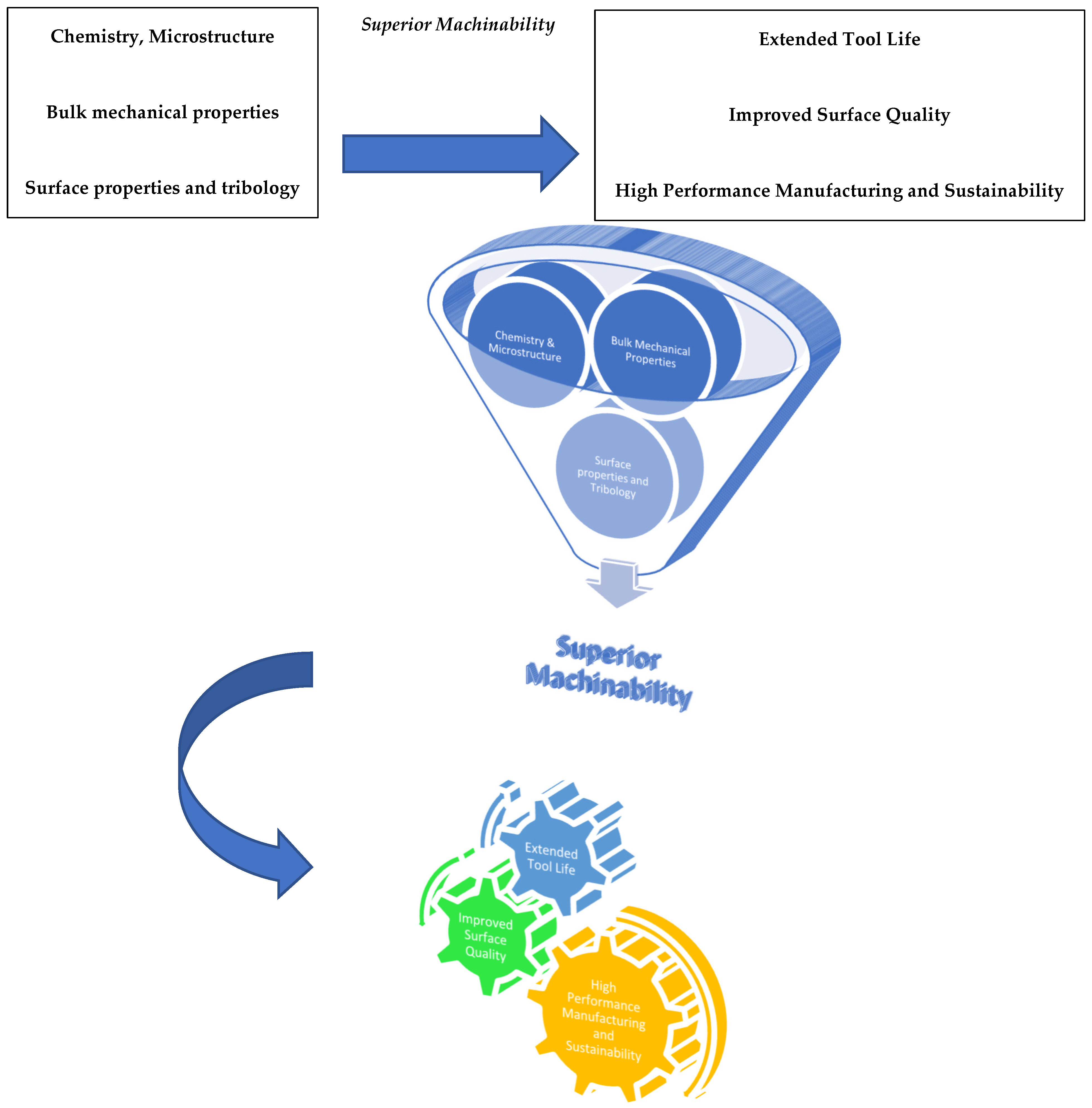Machinability and Tribological Performance of Advanced Alloys
1. Introduction and Scope
2. Contributions
3. Conclusions and Outlook
Funding
Acknowledgments
Conflicts of Interest
Profound Appreciation and Dedication
References
- Duan, Y.; Qu, S.; Jia, S.; Li, X. Evolution of the Fretting Wear Damage of a Complex Phase Compound Layer for a Nitrided High-Carbon High-Chromium Steel. Metals 2020, 10, 1391. [Google Scholar] [CrossRef]
- Du, Z.; Wang, G.; Wang, H. The Process Design and Rapid Superplastic Forming of Industrial AA5083 for a Fender with a Negative Angle in a Small Batch. Metals 2021, 11, 497. [Google Scholar] [CrossRef]
- Khan, S.A.; Rehman, M.; Farooq, M.U.; Ali, M.A.; Naveed, R.; Pruncu, C.I.; Ahmad, W. A Detailed Machinability Assessment of DC53 Steel for Die and Mold Industry through Wire Electric Discharge Machining. Metals 2021, 11, 816. [Google Scholar] [CrossRef]
- Tserpes, K.; Bazios, P.; Pantelakis, S.G.; Pappa, M.; Michailidis, N. Mechanical Characterization of Nanocrystalline Materials via a Finite Element Nanoindentation Model. Metals 2021, 11, 1827. [Google Scholar] [CrossRef]
- Stavroulakis, P.; Toulfatzis, A.I.; Pantazopoulos, G.A.; Paipetis, A.S. Machinable Leaded and Eco-Friendly Brass Alloys for High Performance Manufacturing Processes: A Critical Review. Metals 2022, 12, 246. [Google Scholar] [CrossRef]
- Zhang, G.; Sun, W.; Xie, L.; Zhang, C.; Tan, J.; Peng, X.; Li, Q.; Ma, X.; Zhao, D.; Yu, J. Multicomponent Fe-Based Bulk Metallic Glasses with Excellent Corrosion and Wear Resistances. Metals 2022, 12, 564. [Google Scholar] [CrossRef]
- Vazdirvanidis, A.; Rikos, A.; Toulfatzis, A.I.; Pantazopoulos, G.A. Electron Backscatter Diffraction (EBSD) Analysis of Machinable Lead-Free Brass Alloys: Connecting Texture with Fracture. Metals 2022, 12, 569. [Google Scholar] [CrossRef]
- Kuo, S.-K.; Ou, Y.-L.; Wang, D.-A. An Analytical Model for Stress and Curvature Prediction of a Strip Leveling Process. Metals 2022, 12, 757. [Google Scholar] [CrossRef]
- Vargova, M.; Tavodova, M.; Monkova, K.; Dzupon, M. Research of Resistance of Selected Materials to Abrasive Wear to Increase the Ploughshare Lifetime. Metals 2022, 12, 940. [Google Scholar] [CrossRef]
- Monka, P.P.; Monkova, K.; Vasina, M.; Kubisova, M.; Korol, M.; Sekerakova, A. Effect of Machining Conditions on Temperature and Vickers Microhardness of Chips during Planing. Metals 2022, 12, 1605. [Google Scholar] [CrossRef]
- Yang, Y.; Luan, H.; Guo, S.; Liu, F.; Dai, Y.; Zhang, C.; Zhang, D.; Zhou, G. Tribological Behaviors of Inconel 718–Tungsten Carbide Friction Pair with Sulfur Additive Lubrication. Metals 2022, 12, 1841. [Google Scholar] [CrossRef]
- Mac, T.-B.; Luyen, T.-T.; Nguyen, D.-T. Assessment of the Effect of Thermal-Assisted Machining on the Machinability of SKD11 Alloy Steel. Metals 2023, 13, 699. [Google Scholar] [CrossRef]
- Monka, P.P.; Monkova, K.; Pantazopoulos, G.A.; Toulfatzis, A.I. Effect of Wear on Vibration Amplitude and Chip Shape Characteristics during Machining of Eco-Friendly and Leaded Brass Alloys. Metals 2023, 13, 828. [Google Scholar] [CrossRef]
- Zervaki, A.D.; Lambrakos, S.G.; Mourlas, A.G.; Papantoniou, I.G.; Rodríguez, J.; Psyllaki, P.P. Inverse Thermal Analysis as a Tool for Optimizing Concentrated Solar Energy Elaboration of Wear Resistant Surface Layers. Metals 2023, 13, 942. [Google Scholar] [CrossRef]
- Ishfaq, K.; Sana, M.; Mahmood, M.A.; Anwar, S.; Waseem, M.U. Evaluating Surface Quality of Inconel 617 by Employing Deep Cryogenically Treated Electrodes in Surfactant-Added Dielectrics of Transformer Oil. Metals 2023, 13, 1092. [Google Scholar] [CrossRef]

| Reference Number | Relevant Topic | Materials | ||
|---|---|---|---|---|
| Machinability | Tribology/Surface Properties | Miscellaneous | ||
| [1] | X210CrW12 steel | |||
| [2] | AA5083 Al-alloy | |||
| [3] | DC53 steel | |||
| [4] | W-Cu (nanocrystalline) | |||
| [5] | Copper alloys (brasses) | |||
| [6] | Fe-Bulk metallic glasses | |||
| [7] | Copper alloys (brasses) | |||
| [8] | Mild steel | |||
| [9] | Steels (mainly S355J2G3, 37MnSi5, Hardox 450, UTP 690, OK 84.58) | |||
| [10] | EN C45 carbon steel | |||
| [11] | Inconel 718/WC | |||
| [12] | SKD11 Alloy Steel | |||
| [13] | Brass alloys (CW510L, CW614N, CW724R) | |||
| [14] | TiC/carbon steel, Cr3C2/carbon steel | |||
| [15] | Inconel 617 | |||
Disclaimer/Publisher’s Note: The statements, opinions and data contained in all publications are solely those of the individual author(s) and contributor(s) and not of MDPI and/or the editor(s). MDPI and/or the editor(s) disclaim responsibility for any injury to people or property resulting from any ideas, methods, instructions or products referred to in the content. |
© 2023 by the author. Licensee MDPI, Basel, Switzerland. This article is an open access article distributed under the terms and conditions of the Creative Commons Attribution (CC BY) license (https://creativecommons.org/licenses/by/4.0/).
Share and Cite
Pantazopoulos, G.A. Machinability and Tribological Performance of Advanced Alloys. Metals 2023, 13, 1190. https://doi.org/10.3390/met13071190
Pantazopoulos GA. Machinability and Tribological Performance of Advanced Alloys. Metals. 2023; 13(7):1190. https://doi.org/10.3390/met13071190
Chicago/Turabian StylePantazopoulos, George A. 2023. "Machinability and Tribological Performance of Advanced Alloys" Metals 13, no. 7: 1190. https://doi.org/10.3390/met13071190
APA StylePantazopoulos, G. A. (2023). Machinability and Tribological Performance of Advanced Alloys. Metals, 13(7), 1190. https://doi.org/10.3390/met13071190





